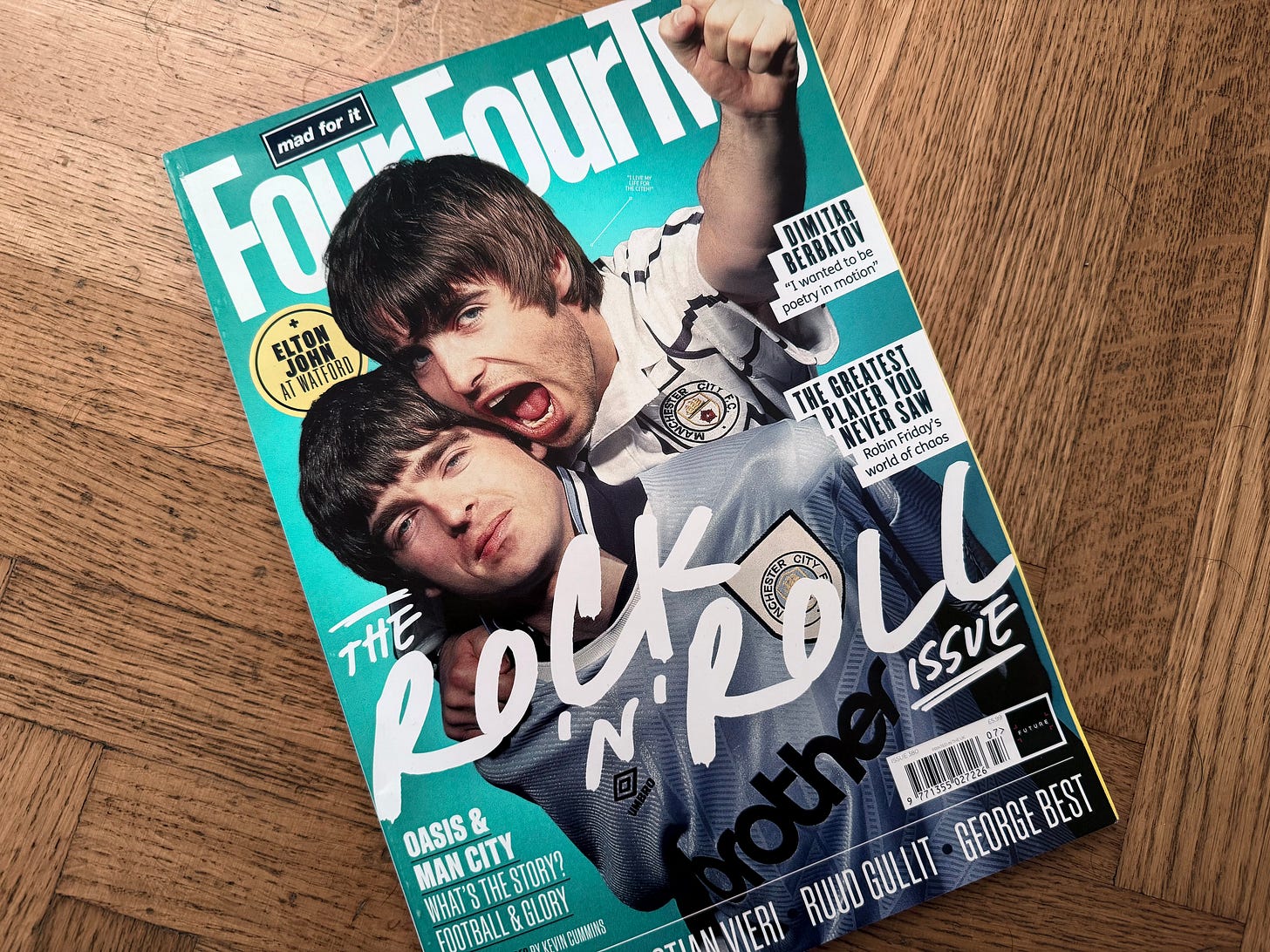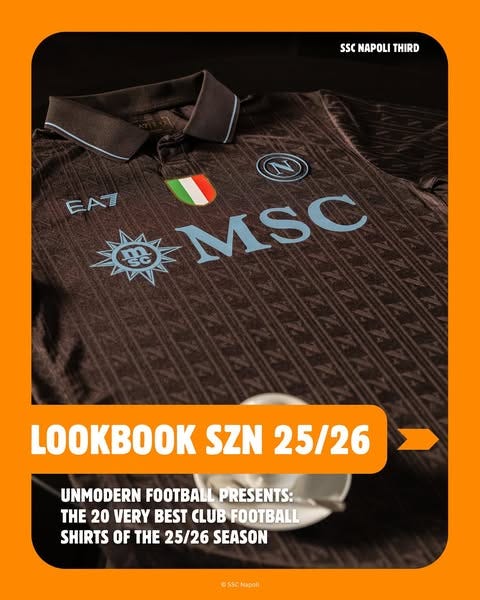From Cringe to Couture: How the Football Shirt Became An Unlikely Fashion Essential
Plus: My 20 favourite football kits of the 25/26 season in the Unmodern Football lookbook.
There was a time – and not that long ago – when wearing a football shirt in public was social suicide.
Outside the stadium, it was code for being uneducated, working class, lower middle-class at best. Particularly in Europe, where class codes run deep and fashion rules are silently policed, a football top on an adult male screamed: tragic.
Not stylish-tragic. Just tragic.
That’s changed. Massively.
Today, a football jersey might get you past the rope at a club, the right shirt even into Berghain (possibly).
Bella Hadid wears vintage Roma.
The guy queuing next to you at the bar is in full 1994 Arsenal away kit, looking like a Euro 96 sticker album and somehow pulling it off. Football shirts – once shameful – are now sexy. Desirable. High fashion, even.
Every new season brings a whole range of brand new kits, with clubs going above and beyond to present their very special third kit, fourth kit, sometimes even fifth during the season.
Speaking of which: Check out my 20 favourite football kits of the 25/26 season in my lookbook over on Instagram:
Entire blogs are devoted to tracking leaks and drops.
A whole industry has emerged around the football shirt, ranging from retro re-issues to capsule collections and collaborations – like the Oasis x adidas team-up featuring a football kit that was sold out in seconds.
It’s bizarre. And fascinating. So what happened?
In the olden times, football shirts weren’t for the high streets.
The football kit had a single purpose: Helping to differentiate two teams on a football pitch and making it easier for fans (and refs) to follow along. This was long before the kit became a performance factor for players, and long before people wore them outside of the stadium.
First came the fan replica.
They were for kids or fanatics. No self-respecting adult walked through town in a polyester billboard.
You supported your team quietly – maybe a pin on your lapel, maybe a scarf in winter. The shirt?
That was for matchday. Or your nephew.
Middle-class fashion, meanwhile, recoiled.
Terrace culture was working-class, loud, sometimes violent. Fashion-conscious fans in the 80s – the “casuals” – dressed around their allegiance.
Burberry jacket: yes.
Sergio Tacchini polo: yes please.
Button-on Stone Island cloth badge: hell yes.
Club crest: absolutely not.
There was an unspoken rule: if you cared about clothes, you didn’t wear the shirt.
(Aside: There’s a whole story about why and how fashion was so important for the English working-class, so much so that my working-class dad still puts on a tie every time he leaves the house.)
The football top was not just uncool. It was culturally coded. And class was doing the coding.
Until Britpop, that is.
There were artists who wore the occasional football shirt before that, of course. The Three Degrees wore a West Brom shirt. Bob Marley donned a Santos kit.
But it really all kicked off with Oasis.
In the 90s, Britpop made it cool to be local again. Bands like Oasis and Blur wore their football loyalties proudly – not just on their sleeves, but all over their torsos.
Noel in his vintage City kit.
Damon Albarn hinting at Chelsea with a track jacket and a sneer.
Football and indie music began to dance together, awkwardly but sincerely. It was anti-fashion as fashion. Aesthetic by accident.
The Britpop uniform? Adidas trainers, bucket hat, trackie top, and the club shirt.
What your older brother wore to the pub became your look for Glastonbury. Suddenly, being into football wasn’t cringe – it was culture.
The lad was reborn as a style icon.
And that was just the warm-up.
Fast-forward to the 2000s: hip-hop’s in love with sport. American rappers rock NFL jerseys. Then NBA ones. And eventually: football shirts. Not “soccer” ones. Football.
Snoop Dogg wore Celtic. Drake wore Juventus. And then: French and German rappers wearing PSG shirts in their music videos.
The football shirt was finally fashion.
And like it or not, while the Gallaghers were the spark, PSG were the catalyst.
Backed by oil money and brand strategy, Paris Saint-Germain positioned itself not just as a club, but a fashion brand.
They partnered with Jordan.
Made kits that looked like Supreme drops.
Hosted events at Fashion Week.
Got Rihanna and Gigi Hadid in their gear.
They turned the football shirt into a flex.
Meanwhile, grime artists in the UK – Skepta, Dave, AJ Tracey – started incorporating PSG shirts into music videos, lyrics, promo shoots, with French and German rappers doing the same across the channel.
It wasn’t ironic. It wasn't a costume. It was everyday wear. Cool by default.
By the late 2010s, the question wasn’t “should I wear a football shirt out?” but “which one do I wear to this party?”
Around 2021, TikTok did what TikTok does: took a niche and memed it into ubiquity.
Enter: blokecore.
A deliberately basic look. Old football shirt, baggy jeans, battered trainers. You looked like you’d just been to the pub in 1996. That was the point.
It spread fast. Asia, Europe, the US. People who’d never kicked a ball in their life were wearing Fiorentina ‘98 kits to music festivals.
Retro shirts became holy grails.
Shops like Classic Football Shirts and Cult Kits became fashion destinations. Football shirts became the new band tees – worn for design, not allegiance.
And the luxury brands?
Of course they joined in.
Balenciaga released their own club line. Off-White did a capsule called Football, Mon Amour. Stella McCartney did Arsenal. Suddenly, £600 football boots were a thing. And they weren’t for playing.
Nowadays, the modern football club is a fashion house. Even perennial underdogs like Arminia Bielefeld do fashion drops every season, with shirts selling out in no time and becoming cherished collectibles.
I used to be the only guy in Vienna running around in a Bielefeld shirt. I am not anymore.
On a quick sidenote, I do acknowledge that I am privileged. With a stable income, I can afford to buy half a dozen kits per season. Many can’t, and there’s a discussion to be had about how modern football fashion puts a lot of pressure on fans, especially from the low-income demographics. I am not going to pretend that’s not a problem.
But for today, coming from the POV of someone who always felt out of place wearing a shirt around town, I want to focus on this unexpected but welcome development:
What’s interesting – and slightly absurd – is how fast the football shirt flipped from fashion faux-pas to fashion-forward.
A piece of clothing that once marked you as a walking stereotype now grants you subcultural capital.
Wearing a vintage Arminia Bielefeld kit isn’t just nostalgia. It’s taste.
And taste, let’s be honest, is what this whole shift is about. The snobbery is still there – it’s just in reverse.
You get more cred for wearing a retro Serie A top than for carrying a Prada bag.
Sure, I could go all “My culture is not your costume” over this.
But frankly, as a 43 year old man who grew up being looked down upon for being a full kit w*nker in the 90s, this is refreshing.
It’s amazing to see not only young lads but young and old ladettes running around in Bundesliga or Premier League kits outside of a stadium.
I am really happy that I can go out and meet friends in one of my many football shirts and nobody will bat an eye.
Of course I have my rules. I don’t wear a kit from one of the three professional leagues in Germany other than my team Arminia Bielefeld. And in a stadium I would only ever wear Arminia. But outside of that? Whether it’s a 96 AC Milan away shirt, or an early 2000s OM kit, or the latest Arsenal beauty – the most important factor is: Does the shirt look good?
The answer almost always is: yes.
Thank you, Gallaghers.
Most importantly, nobody looks at you funny anymore.
Unless you’re wearing RB Leipzig.
Then, frankly, you deserve it.
Over to you: What is your all-time favourite shirt? Which kits of the 25/26 season do you like? And what shirts are you planning on getting?
And make sure to check out the Unmodern Football lookbook on Instagram.





Greetings from Bucharest and thanks for the really cool read. I saw myself in your experience. I went to high school in the early 2000s, and my best friend and I were the only ones who consistently came to school wearing the jerseys of our favorite clubs (or European clubs whose fake jerseys we found in markets). I support Progresul Bucuresti, and my mate supports Rapid. Since we went to a rather bourgeois high school, a good part of the more fashionable and elitist schoolmates, as well as the metalheads and punks, looked down on us. No members of any subcultures would wear football jerseys. Back then, only low-lifes and hooligans went to the stadium, in their minds. It's funny that nowadays you see those types of people wearing the jerseys of the clubs you mentioned. I admit that gives me a kind of useless satisfaction because: I did this before it was cool.
really cool article .. glad that you highlighted the plight of wearing a football shirt in the streets during the 1990s